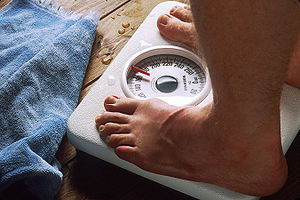 Image via WikipediaToday we are discussing how to get over that "plateau" that seems to occur from time to time, jeopardizing your weight loss goals - this can really do a number on your motivation to stick to your exercise plan, so it's important to learn some ways to get through these periods.
Image via WikipediaToday we are discussing how to get over that "plateau" that seems to occur from time to time, jeopardizing your weight loss goals - this can really do a number on your motivation to stick to your exercise plan, so it's important to learn some ways to get through these periods. Here’s a little bit of geography. A plateau is a flat area of land. It has no peaks or valleys and even small changes in elevation are met with more leveling off flat areas.
Plateaus are used to describe what happens when your weight-loss program seems to hit a brick wall. You are continuing with your program but the scale doesn’t seem to want to budge. It can strike a devastating blow to dieters who once saw great losses with the program they are following.
Don’t lose heart. Plateaus occur in just about everyone’s weight-loss journey at one time or another. But, one key to overcoming them is to be prepared for when they come. Knowing what to do next can save you from throwing in the towel altogether.
Why Plateaus Occur
The body is a machine. You feed it and it uses that fuel to go about its daily processes. When given the right foods, it will burn fat stores for energy. More energy out and less food intake equals a lower body weight for you.
When you first begin an exercise or dieting program, there is a caloric deficit because you are changing something. Either there is a decrease in food intake or you have a greater calorie output through exercise. In response to exercise, the body burns more calories because you are doing something new with it. The muscles are confused and need to catch up. This is good.
 Image via WikipediaOver time, however, the body can get used to the routine. If you are exercising, you may notice that you are no longer huffing and puffing when you perform a certain exercise. The body is predicting your routine and getting bored. It only burns the minimum calories needed which means that you are not getting as much of a benefit as you once were.
Image via WikipediaOver time, however, the body can get used to the routine. If you are exercising, you may notice that you are no longer huffing and puffing when you perform a certain exercise. The body is predicting your routine and getting bored. It only burns the minimum calories needed which means that you are not getting as much of a benefit as you once were.Jumping Off That Plateau
Now that you know how you came to encounter the plateau, it’s time to jump off of it. Here are some suggestions to do that.
* Change your fitness routine – Physical trainers recommend changing your fitness routine every four to six weeks. You don’t have to change your entire routine, just add to it. If you are doing only cardio workouts, add some weight training to break it up and confuse those muscles into burning more fat. (Interval training is a GREAT way to break through the plateau, as you are constantly changing both activity and intensity.)
* Check your diet – As we get more confident in our eating habits, sometimes we relax them. The portion size may be creeping up or we are eating out more. Use a food diary to see what changes, if any, have occurred that could be adding more calories to your day.
* Supplementation – It may be time to boost your results with some supplements. Check with a nutritionist to see which would be helpful for metabolism or appetite suppression.
Plateaus don’t have to derail your weight-loss program. Learn to recognize them and jump off as soon as you encounter them.

No comments:
Post a Comment